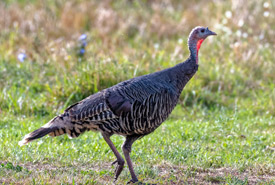10 fascinating facts about wild turkeys

Wild turkey (Photo by D.P. Lawrence CC-BY-NC)
Today marks Thanksgiving in Canada. The first official, annual Canadian Thanksgiving took place on November 6, 1879. In honour of Thanksgiving, here are 10 facts to gobble up about wild turkeys, a species that has been documented on Nature Conservancy of Canada properties in Ontario and Quebec:
1. Male wild turkeys are called “toms,” while females are called “hens.”
2. At the start of spring, male wild turkeys get together in clearings to perform courtship displays. They puff up their feathers, lower their wings, fan out their tails and slowly strut, while making their famous gobble sounds.
3. Believe it or not, wild turkeys can fly. At nighttime, they fly up into trees to roost.
4. Wild turkeys were extirpated (locally extinct) from Ontario as a result of habitat loss and over-hunting. Reintroduction efforts began in 1984. Turkeys are now a common sight in southern Ontario and Quebec, and they are continuing to expand their range.
5. An adult turkey can have more than 6,000 feathers.
6. The historic range of wild turkeys in Canada was probably limited to southern Ontario and Quebec. Today, scattered populations can also be found in western Canada as a result of introductions.
7. Wild turkeys mostly inhabit forests but often wander into open fields and grasslands to feed.
8. Wild turkeys are not fussy eaters. They feed on hickory nuts, beech nuts, acorns, fruit, snails, worms and amphibians.
9. Wild turkeys can run at speeds of up to 19 kilometres per hour.
10. Certain characteristics of wild turkey droppings, such as their shape and size, reveal the turkey's gender and age. Female droppings are spiral shaped, while male droppings are J-shaped. The larger the diameter, the older the bird.


